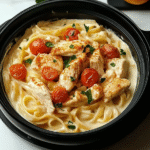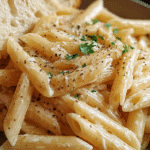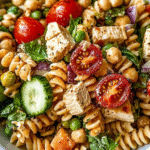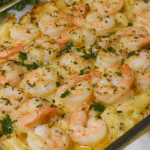5 Ways to Make a 5-Star Restaurant Pasta at Home – Bring Gourmet Flavor to Your Kitchen
Let’s be real: there’s something irresistible about twirling a forkful of perfectly sauced, glossy pasta that clings like it was made in a Michelin-starred kitchen. That’s the magic of 5-star restaurant pasta — and guess what? You don’t need a reservation to enjoy it. I’m here to show you exactly how to bring restaurant-quality pasta at home using five foolproof chef-backed methods. And the best part? These aren’t complex tricks that require culinary school credentials — they’re simple, transformative steps you can pull off with basic pantry staples and a little confidence.
What really makes 5-star pasta pop is the process. It’s how you handle the heat, the water, the timing, and the final touches. From saving that starchy pasta water to building flavor in layers and swirling in cold butter for that restaurant-level gloss — we’re diving deep into what separates average pasta from unforgettable plates. Whether you’re cooking for a date, impressing family, or upgrading your solo dinner game, these techniques will help you crush it every time.
What’s on the Plate
Overview
Cuisine: Italian-American Fusion
Course: Dinner, How-To
Prep Time: 15 minutes
Cook Time: 25 minutes
Total Time: 40 minutes
Serving: Serves 2–4
What’s in Every Bite (Approximate per serving)
Calories: ~490 kcal
Carbs: 54g
Fats: 22g
Protein: 18g
Sugar: 4g
Sodium: 630mg
Fiber: 3g
Total Recipe Cost (Approximate)
Total Cost: ~$10–12 USD
Per Serving: ~$2.50–3.00
Main Cost Factors: cheese, butter, pasta, olive oil
The Story Behind the Flavor
The love affair with 5-star restaurant pasta began for me in a cramped Roman trattoria. I ordered cacio e pepe — and it was perfection. That silky, glossy texture. That deep, cheesy richness. I knew right then I had to figure out how to recreate that experience at home. After years of cooking in restaurant kitchens and learning from seasoned Italian chefs, I discovered it wasn’t about fancy tools — it was about method.
This article breaks down what separates your everyday spaghetti from true gourmet pasta at home. The difference lies in five transformative techniques. Master these, and you’ll never settle for ordinary noodles again.
Perfect For
- Elevating your date night dinners
- Impressing guests without fancy ingredients
- Turning pantry staples into chef-level dishes
- Practicing plating and presentation skills
- Boosting your confidence as a home cook
Why You’ll Love This Recipe
- Breaks down restaurant secrets in simple steps
- Works with any pasta shape or sauce
- Turns store-bought sauce into gourmet
- Helps build skills, not just recipes
- Beginner-friendly but chef-approved
Ingredients You’ll Need
Core Techniques Ingredients
- 8 oz dried pasta (linguine, spaghetti, or penne)
- Kosher salt for the water
- 2 tablespoons unsalted butter (or olive oil)
- 1/2 cup grated Parmesan or Pecorino Romano
- Optional: garlic, chili flakes, herbs, lemon zest
Ingredient Highlights
Pasta: Dried pasta works perfectly — just aim for bronze-cut for better sauce grip.
Cheese: Use high-quality hard cheeses like Parmesan or Pecorino.
Butter & Olive Oil: Fats help emulsify the sauce and finish with gloss.
Salt: Properly salted water flavors your noodles inside out.
Pasta Water: Rich in starch and essential for sauce texture.
Step-by-Step Instructions
1. Finish Pasta in the Sauce
Cook pasta until it’s 1–2 minutes shy of done. Transfer it directly to your hot sauce pan and toss until the sauce reduces and clings. That’s how to make sauce stick to pasta like the pros do.
2. Save and Use Pasta Water
Reserve a cup of starchy pasta water before draining. Add it gradually to the sauce while stirring. It helps emulsify the sauce, making it rich without needing cream.
3. Undercook Pasta and Let the Pan Finish the Job
Pull your pasta early and finish cooking it in the sauce. This builds flavor and keeps the texture firm, not mushy. It’s one of the simplest pasta tips for beginners that makes a big impact.
4. Add Butter, Olive Oil, or Cheese Off-Heat
Remove your pasta from heat and stir in cold butter, a drizzle of olive oil, or grated cheese. This adds body, shine, and depth — no heavy cream needed.
5. Season Every Layer
Salt the water generously (1–1.5 tbsp per 4 quarts). Taste and adjust sauces as you go. A final pinch of sea salt at the end can make your dish pop.
Pro Chef Tips
- Use tongs to toss pasta evenly in sauce
- Never rinse pasta — you’ll lose the starch
- Always taste as you go — balance is everything
- Try a microplane for the finest cheese texture
- Practice plating with a pasta nest and garnishes
Recipe Variations
Creamy Lemon Pasta: Add lemon zest, garlic, and pasta water to melted butter. Finish with Parmesan.
Spicy Arrabbiata: Use chili flakes and garlic sautéed in oil. Stir in crushed tomatoes and finish with basil.
Garlic Butter Mushroom Pasta: Sauté mushrooms in butter and garlic, toss in cooked pasta, and finish with cheese.
Tomato Basil Twist: Use fresh tomatoes sautéed with olive oil and garlic, finish with torn basil and cheese.
Gluten-Free Version
Use your favorite gluten-free pasta and ensure cheese and butter are GF-certified. The technique stays exactly the same.
Kid-Friendly Version
- Use mild cheese and skip chili flakes
- Let kids help stir in the sauce and plate the pasta
- Serve with a simple marinara or butter sauce
5 Ways to Make a 5-Star Restaurant Pasta at Home
Ingredients
Method
- Cook pasta until it’s 1–2 minutes shy of done. Transfer it directly to your hot sauce pan and toss until the sauce reduces and clings. That’s how to make sauce stick to pasta like the pros do.
- Reserve a cup of starchy pasta water before draining. Add it gradually to the sauce while stirring. It helps emulsify the sauce, making it rich without needing cream.
- Pull your pasta early and finish cooking it in the sauce. This builds flavor and keeps the texture firm, not mushy. It’s one of the simplest pasta tips for beginners that makes a big impact.
- Remove your pasta from heat and stir in cold butter, a drizzle of olive oil, or grated cheese. This adds body, shine, and depth — no heavy cream needed.
- Salt the water generously (1–1.5 tbsp per 4 quarts). Taste and adjust sauces as you go. A final pinch of sea salt at the end can make your dish pop.
Notes
5 Ways to Make a 5-Star Restaurant Pasta at Home – Helpful Tips
Cooking Tips & Techniques1. Salt Like a Chef: Always salt your pasta water generously—it should taste like the sea. This is your only chance to season the pasta itself.
2. Don’t Rinse That Pasta: After boiling, skip the rinse. Starchy pasta water helps your sauce cling beautifully and adds silkiness.
3. Finish Pasta In the Sauce: Toss hot pasta directly into the sauce and cook for 1–2 minutes more. This builds flavor and creates a restaurant-style emulsion.
4. Use Quality Ingredients: Upgrade your pantry—use imported pasta, real Parmigiano-Reggiano, and cold-pressed olive oil.
5. Balance Your Flavors: Add brightness with a splash of lemon juice or vinegar, richness with butter or cream, and depth with garlic, shallots, or wine. Serving Suggestions
Plate pasta in a nest with a swirl, then top with sauce—not the other way around. Garnish with herbs, cheese shavings, or infused oil.
Serve alongside fresh bread, a simple arugula salad, or roasted vegetables.
Add finishing touches: lemon zest, fresh basil, or a drizzle of high-quality olive oil for a professional flair.
Pair with wine that complements the sauce—light whites for creamy or lemony sauces, bold reds for meaty ragùs. Make-Ahead & Storage
Make-Ahead: Sauces (especially tomato-based or creamy ones) can be made 1–2 days in advance and reheated gently.
Refrigerator: Store pasta and sauce separately when possible, up to 3–4 days in airtight containers.
Freezer: Freeze cooked sauce for up to 2 months. Freeze pasta only if sauced—plain pasta can become gummy.
Reheat: Warm pasta gently on the stovetop with a splash of reserved pasta water or broth to restore creaminess and texture. Tasty Variations to Try
Truffle Oil Drizzle: A few drops on creamy Alfredo or mushroom pasta take it over the top.
Seafood Upgrade: Add shrimp, scallops, or lump crab to your pasta for elegant, briny richness.
Herbed Butter Toss: Stir in compound butter with garlic, lemon, or parsley for instant flavor.
Roasted Veggie Boost: Toss in roasted tomatoes, squash, or eggplant for texture and depth.
Protein Power: Add grilled chicken, sausage, or pancetta for heartier versions that still feel upscale.
More Recipe’s to Dig
You Can Dig Deeper into Recipes by clicking this: Appetizer, Breakfast, Lunch, Dinner, and Desserts.
Storage & Reheating
Refrigerator: Store cooled pasta in a sealed container for up to 3 days.
Reheat: Splash in a little water and reheat in a saucepan or microwave until warmed through. Stir to refresh the sauce.
Equipment
- Large pasta pot
- Skillet or sauté pan
- Tongs or pasta fork
- Cheese grater
- Measuring spoons and ladle
FAQs
Why doesn’t my pasta sauce stick to the noodles?
If you rinse pasta or don’t finish it in the sauce, the starch that binds the sauce is lost.
What’s the secret to creamy pasta without cream?
Starchy pasta water and grated cheese emulsify naturally for a velvety texture.
How can I make pasta taste like a 5-star restaurant?
Finish it in sauce, season every layer, and stir in butter or cheese off-heat.
What are the best chef pasta cooking techniques for home cooks?
Save pasta water, finish in sauce, and layer your seasoning and fat for rich, balanced flavor.
How do I make store-bought pasta sauce taste homemade?
Heat it with garlic or chili flakes, add starchy pasta water, and finish with cheese and butter.
What pasta tips for beginners should I know?
Salt your water generously, don’t overcook your pasta, and use your sauce pan for the final toss.
External Resources
Olive Oil Grades Explained – North American Olive Oil Association
Conclusion
Here’s the bottom line: making 5-star restaurant pasta at home is less about expensive ingredients and more about intention. If you learn to respect the pasta water, season thoughtfully, cook with purpose, and finish with finesse, your dishes will speak for themselves.
These techniques aren’t just chef tricks — they’re tools that give you confidence and creative freedom in your own kitchen. So whether you’re cooking for two or just for you, don’t just boil and sauce. Elevate every step. You deserve that restaurant-level satisfaction — right at home.
And hey, when your pasta looks glossy, perfectly plated, and pulls compliments like a pro? Snap a photo and tag me. I want in on that pasta glory. Until then — keep twirling, keep learning, and keep cooking like a chef.






